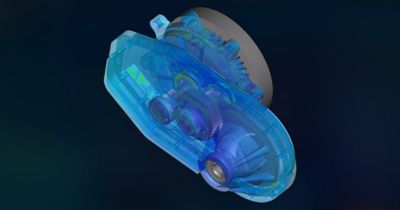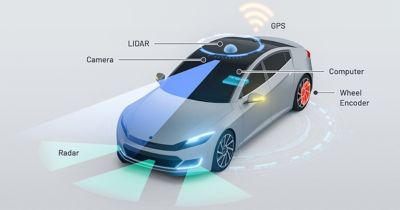-
United States -
United Kingdom -
India -
France -
Deutschland -
Italia -
日本 -
대한민국 -
中国 -
台灣
-
Ansys는 학생들에게 시뮬레이션 엔지니어링 소프트웨어를 무료로 제공함으로써 오늘날의 학생들의 성장을 지속적으로 지원하고 있습니다.
-
Ansys는 학생들에게 시뮬레이션 엔지니어링 소프트웨어를 무료로 제공함으로써 오늘날의 학생들의 성장을 지속적으로 지원하고 있습니다.
-
Ansys는 학생들에게 시뮬레이션 엔지니어링 소프트웨어를 무료로 제공함으로써 오늘날의 학생들의 성장을 지속적으로 지원하고 있습니다.

Vehicle lighting technology has seen significant evolution over the past few decades. What started as simple incandescent bulbs has progressed to sophisticated light-emitting diode (LED) systems, adaptive lighting, and even fully digital lighting solutions. As the automotive industry shifts toward more connected, autonomous, and electric vehicles, demand for innovative lighting solutions is greater than ever. Ansys is at the forefront of this revolution, particularly with its advanced Ansys Optics suite of products, including Ansys Lumerical solvers, Ansys Speos CAD integrated optical and lighting simulation software, and Ansys Zemax OpticStudio optical system design and analysis software.

The Evolution of Vehicle Lighting
From Incandescent to LED
The journey of vehicle lighting began with basic incandescent bulbs. These were simple and reliable but not particularly efficient or durable. The introduction of halogen lamps in the 1960s offered improvements in brightness and longevity. However, it wasn’t until the advent of LED technology that vehicle lighting would transform significantly.
LEDs brought several advantages: They were energy-efficient, had longer life spans, and offered greater design flexibility. This flexibility has enabled automakers to experiment with lighting designs, integrating them into a vehicle’s overall aesthetic and functional design.
Adaptive Lighting and Beyond
The next major leap in vehicle lighting was the development of adaptive lighting systems. These systems, often integrated with a vehicle’s sensors and cameras, can adjust the direction, intensity, and spread of the light beam based on driving conditions. For instance, adaptive headlights can pivot to illuminate the road ahead when the vehicle is turning or automatically switch between high and low beams depending on traffic conditions.
The rise of electric vehicles (EVs) and autonomous vehicles (AVs) is further pushing the boundaries of vehicle lighting technology. With fewer design constraints compared with traditional combustion engine vehicles, EVs offer more opportunities for innovative lighting solutions. Autonomous vehicles, on the other hand, rely heavily on advanced sensor systems, many of which can be integrated with lighting systems to enhance vehicle safety and communication with other road users.

The Future of Vehicle Lighting: Key Trends
Digital Lighting Systems
Digital lighting is set to change the automotive industry. These systems use micro-LEDs or organic LEDs (OLEDs) to create complex lighting patterns and animations. Digital lighting can enhance vehicle communication, for example, by projecting signals or messages onto a road to interact with pedestrians and other vehicles. This will be crucial as we move toward higher levels of vehicle autonomy, in which clear communication between the vehicle and its surroundings will be essential.
Laser and Matrix Lighting
Laser lighting and matrix LED systems represent the cutting edge of vehicle headlight technology. Laser headlights offer greater brightness and range than traditional LED lights, enabling safer driving at higher speeds and in poor visibility conditions. Matrix LED systems, on the other hand, consist of an array of LEDs that can be individually controlled to create precise lighting patterns. This gives better control over light distribution, minimizing glare for oncoming drivers while maximizing road illumination.
Augmented Reality and Head-up Displays
Augmented reality (AR) in vehicles is another exciting area in which lighting technology is playing a crucial role. AR head-up displays (HUDs) project critical driving information directly onto a windshield, allowing drivers to access this data without taking their eyes off the road. Future AR systems could be integrated with advanced lighting solutions, such as projecting navigational cues onto the road or highlighting potential hazards in real time.

Ansys Optics: Driving Innovation in Vehicle Lighting
Comprehensive Simulation Tools
Ansys Optics offers a comprehensive suite of simulation tools that enable automotive engineers to design, test, and optimize vehicle lighting systems in a virtual environment. These tools cover everything from the optical design of individual components to the integration of lighting systems with the overall vehicle design.
One of the key advantages of using the capabilities of the Ansys Optics product collection is its ability to simulate real-world conditions with high accuracy. Engineers can test how different lighting designs perform under various driving conditions, such as different weather conditions, road types, and traffic scenarios. This helps to ensure that a lighting system not only meets regulatory requirements but delivers optimal performance in real-world situations.
Supporting Advanced Lighting Technologies
Ansys Optics is particularly well suited for developing advanced lighting technologies, such as matrix LEDs, laser lights, and digital lighting systems. The product collection enables engineers to simulate the complex interactions between light and different materials, including how light is reflected, refracted, and absorbed. This is critical for optimizing the performance of these advanced lighting systems and ensuring they deliver the desired lighting effects.
For example, in the case of matrix LED systems, Ansys Optics products can simulate how each individual LED interacts with the surrounding optics to produce precise lighting patterns. This level of detail is essential for developing adaptive lighting systems that can dynamically adjust the light distribution based on the driving environment.
Integration With Autonomous Vehicle Systems
As vehicles become more autonomous, the integration between lighting systems and a vehicle’s sensor suite will become increasingly important. Ansys Optics supports this integration by providing tools for simulating how lighting interacts with the vehicle’s cameras, lidar, and other sensors. This helps ensure that the lighting system enhances the performance of these sensors rather than interfering with them.
For example, Ansys Optics products can be used to simulate how different lighting conditions affect the performance of a vehicle’s cameras and lidar systems. This is critical for ensuring that an autonomous vehicle can accurately detect and respond to its surroundings, even in challenging lighting conditions.
Virtual Prototyping and Testing
One of the key benefits of Ansys Optics products is their ability to support virtual prototyping and testing. This enables automotive engineers to test lighting designs in a virtual environment before committing to physical prototypes. This not only speeds up the development process but reduces costs by minimizing the need for expensive physical prototypes.
In addition, Ansys Optics supports the development of digital twins, which are virtual replicas of a physical lighting system. These digital twins can be used to monitor the performance of the lighting system in real time, enabling predictive maintenance and optimization throughout the vehicle’s life cycle.

A Smarter, Safer Future
The future of vehicle lighting is bright, with advanced technologies — such as digital lighting, matrix LEDs, and AR HUDs — set to revolutionize the driving experience. As the automotive industry continues to evolve, so too will demands on vehicle lighting systems. By enabling comprehensive simulation, virtual prototyping, and integration with autonomous vehicle systems, Ansys Optics is helping to ensure that the vehicles of the future are not only safer and more efficient but more connected and intelligent.
Whether you’re an automotive engineer, a designer, or simply a technology enthusiast, advancements in vehicle lighting are exciting developments to watch as we drive toward a smarter, safer, and more visually stunning automotive future.
To learn more, visit Ansys Optics.
The Advantage Blog
The Ansys Advantage blog, featuring contributions from Ansys and other technology experts, keeps you updated on how Ansys simulation is powering innovation that drives human advancement.














